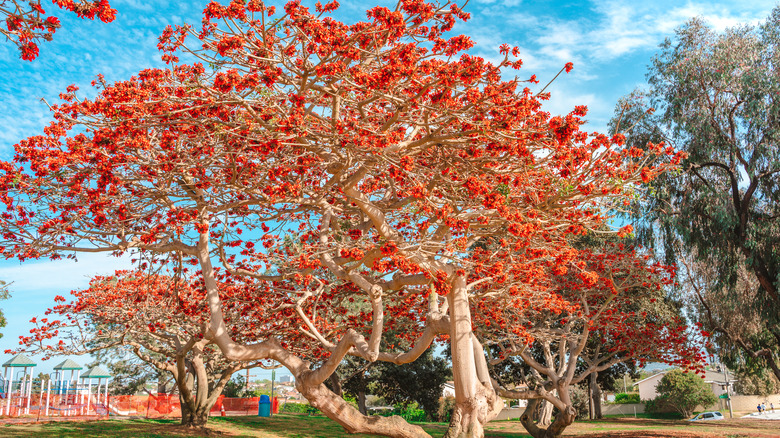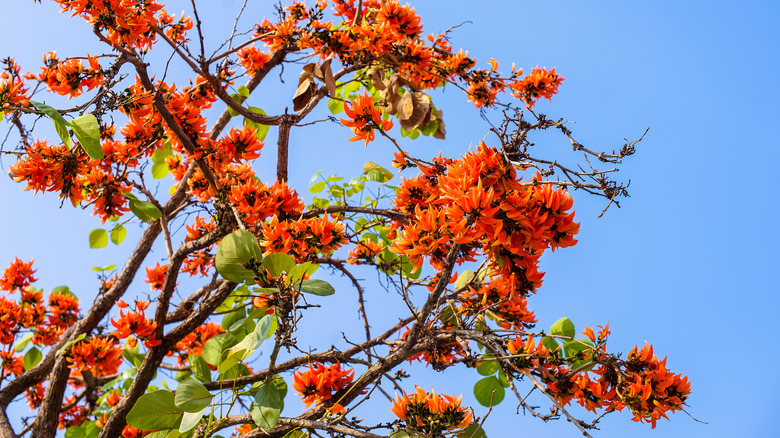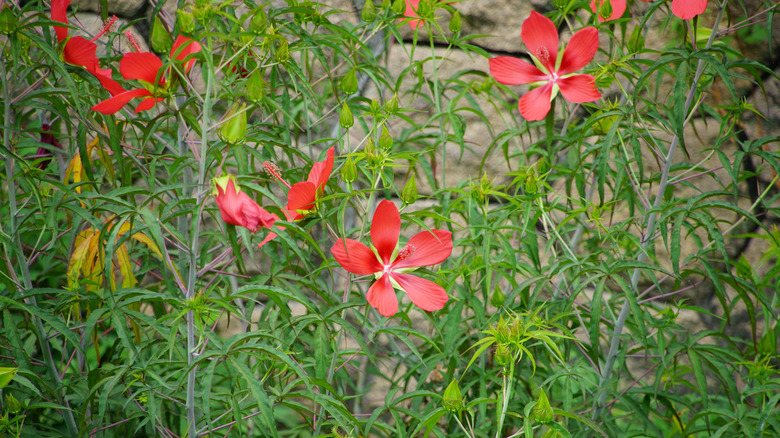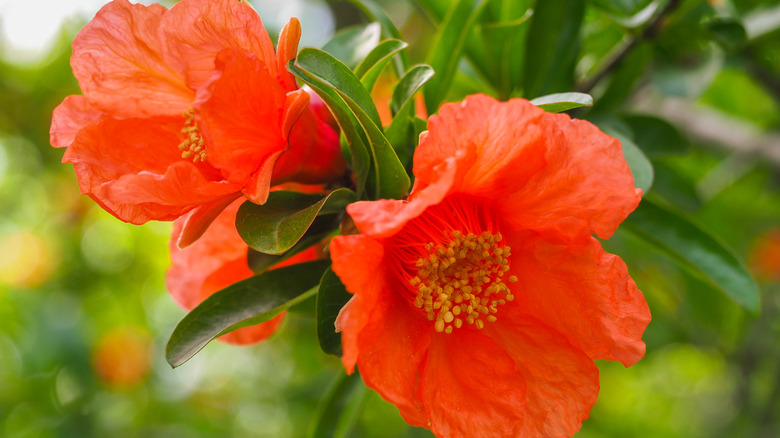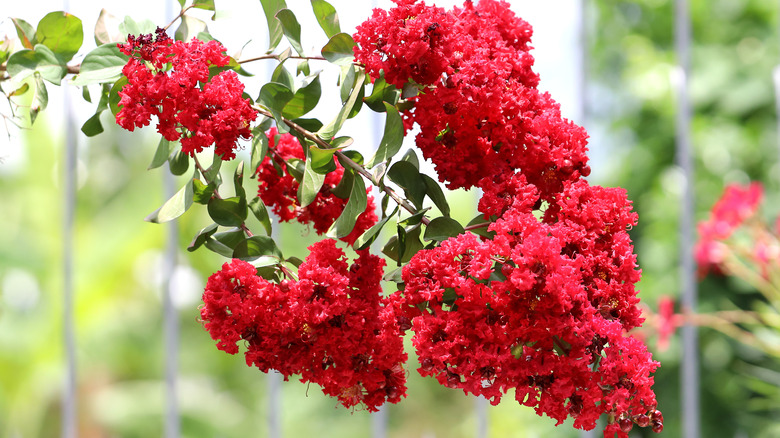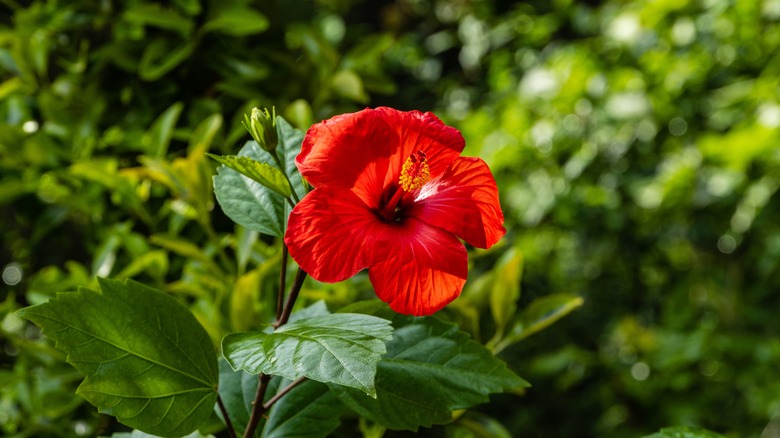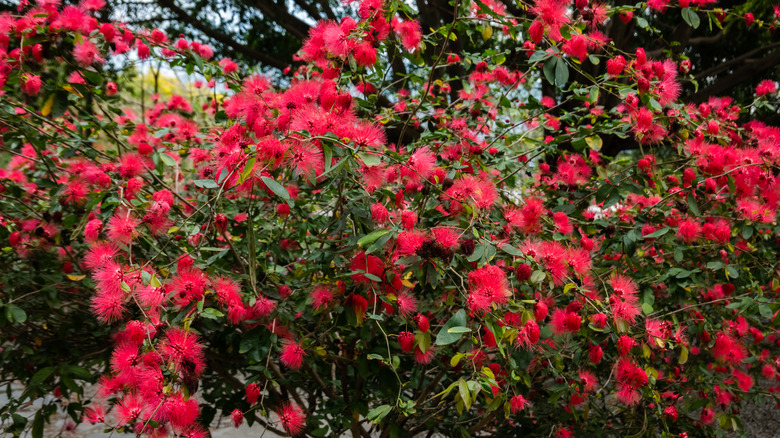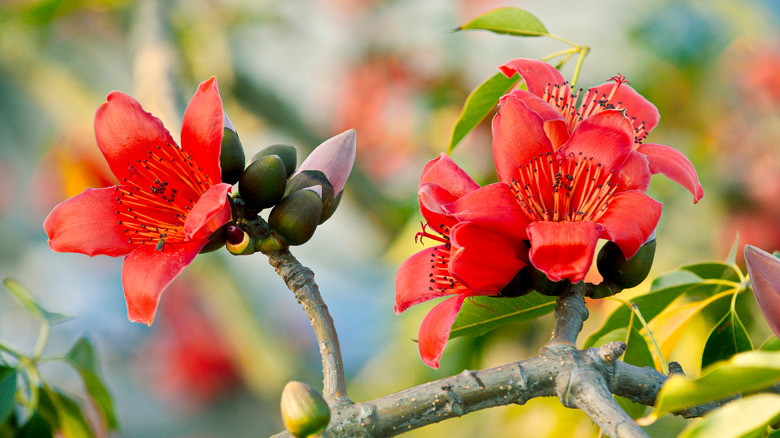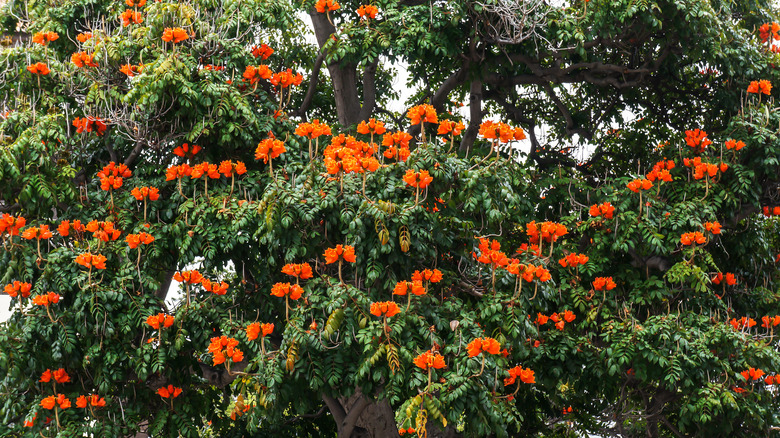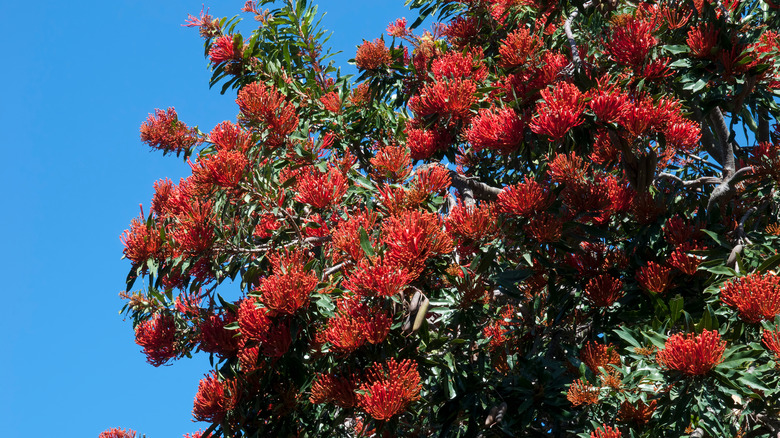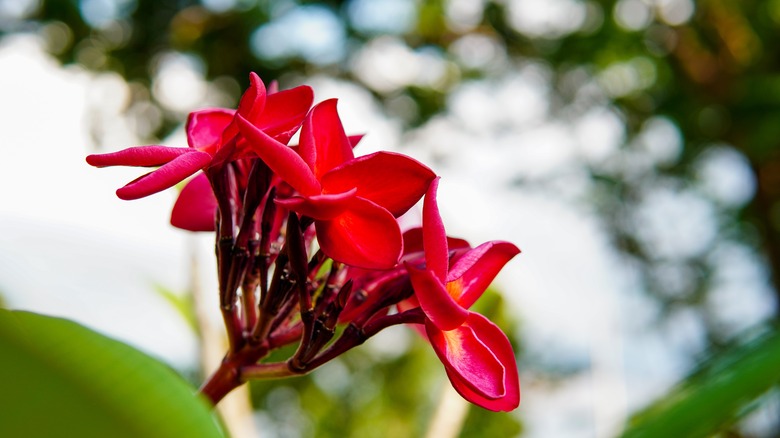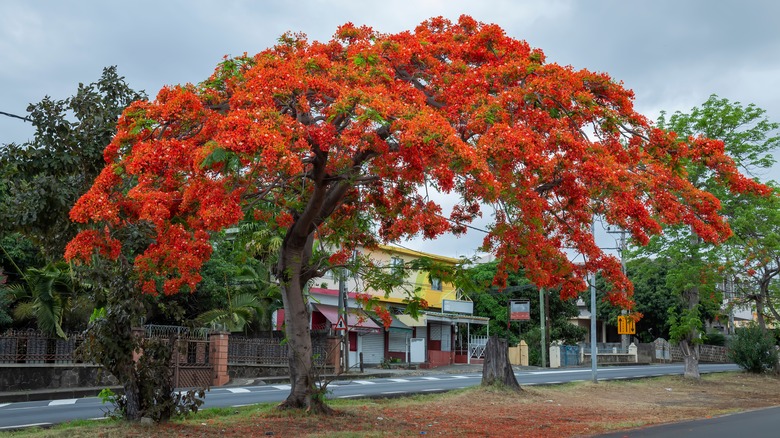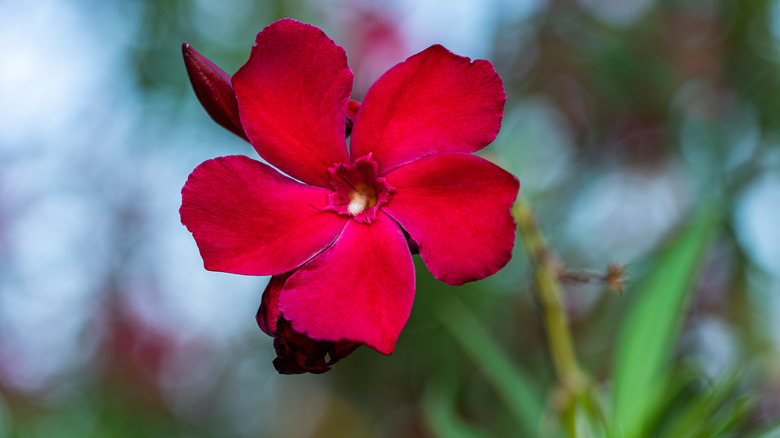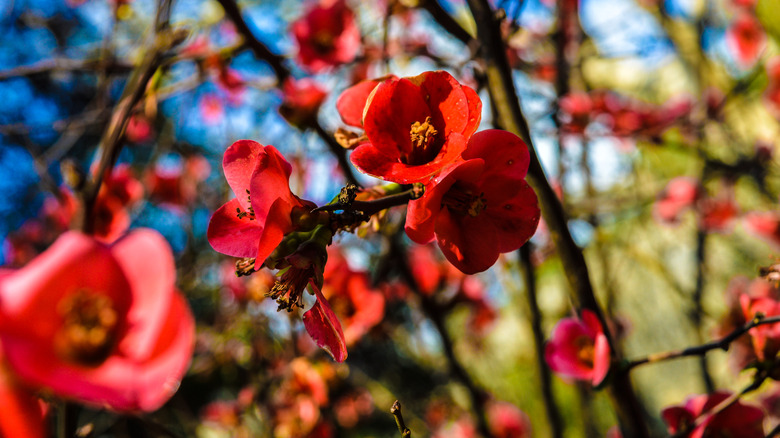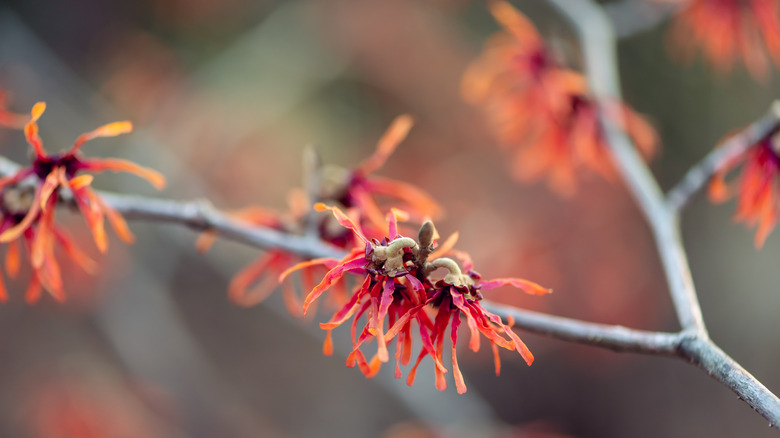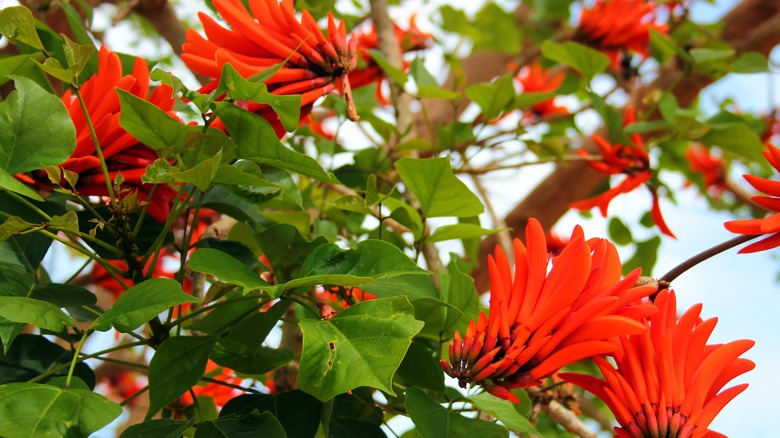15 Trees That Bloom With Gorgeous Red Flowers
Sometimes, your typical tulips, rose bushes, or carnations aren't enough for your home's landscape. When you are looking for something bigger and better, don't be afraid to look into red flowering trees. Some believe that trees are too overpowering for a garden, but we think they can enhance the backdrop of a perfectly designed plot. Even The Garden Design Co. agrees — playing with height variation in your yard can seriously pay off. There are many sizes to choose from. Consider a tree-like shrub such as the scarlet rose mallow hibiscus or something larger like the red silk cotton tree.
Red flowering trees are not few and far between. Change up the look of your lawn or garden with one or more of these 15 trees. But first, make sure that you consider your USDA hardiness zone, growing conditions, soil type, and the size of your property. This way, you can be positive that your tree will grow successfully for as long as possible.
1. Flame of the forest
Flame of the forest (Butea monosperma) is a deciduous tree that features large, leathery green leaves and 2-inch long red and orange flowers. It is native to the hot and humid climate of India and Sri Lanka's lowland forests, as described by Missouri Botanical Garden. Today, you can grow this tree in a few U.S. states that mimic this tree's natural environment.
Bloom Season: Winter to spring
USDA Growing Zone: 10 to 12
Growing Conditions: Full sun and part shade
Soil Type: Fertile, organically rich, and well-draining
Size: 30 to 40 feet tall
2. Scarlet rose mallow hibiscus
Scarlet rose mallow hibiscus (Hibiscus coccineus) is technically a herbaceous perennial, but it is often mistaken for a tree due to its tall growth habit. This hibiscus plant produces large red flowers that can be up to 6 inches in diameter, says North Carolina State Extension. With its tall stature, large leaves, and showy flowers, this tree is popularly grown in Florida, Georgia, and Alabama.
Bloom Season: Summer and fall
USDA Growing Zone: 5 to 9
Growing Conditions: Full sun and partial shade
Soil Type: Moist
Size: 6 to 8 feet tall
3. Pomegranate tree
Pomegranate trees (Punica granatum) are known for being drought-resistant, heat-loving, and hedge-tolerant, according to Washington College. You can identify a pomegranate tree by its glossy, oval leaves, and its round, red fruit that features thick skin. Before Punica granatum produces fruit, it will also display small red or orange flowers.
Bloom Season: Early spring to late summer
USDA Growing Zone: 8 to 12
Growing Conditions: Full sun
Soil Type: Well-draining sand, clay, or loam
Size: Up to 20 feet tall and wide
4. Crape Myrtle
Crape Myrtle (Lagerstroemia indica), also known as the lilac of the south, as told by Arbor Day Trees, is a small tree that produces gorgeous pink and red blossoms throughout the spring, summer, and fall. It is known for its color-changing foliage, and its ability to grow in warm, sunny climates.
Bloom Season: Late spring to fall
USDA Growing Zone: 6 to 9
Growing Conditions: Full sun
Soil Type: Moist and well-draining
Size: 15 to 25 feet tall
5. Tropical hibiscus
Tropical hibiscus (Hibiscus rosa-sinensis), like other hibiscus species, is a tall shrub. Though it comes in a variety of colors when it blooms, many love the classic red that several cultivars provide. As explained by Smithsonian Gardens, this hibiscus plant makes for a beautiful specimen in a yard, or you can grow some close together for a privacy screen.
Bloom Season: Spring and summer
USDA Growing Zone: 9 to 12
Growing Conditions: Full sun
Soil Type: Well-drained
Size: Up to 10 feet tall and 6 feet wide
6. Red powder puff
Calliandra, or the red powder puff tree (Calliandra haematocephala), was first discovered in Bolivia, but it has spread widely since then, as per the University of Arizona. This tree is characterized by its short stature and bright red flowers that look like powder puffs. These flowers are very attractive to pollinators such as bees, butterflies, and hummingbirds, which help keep the tree free of pests.
Bloom Season: Summer
USDA Growing Zone: 9 to 11
Growing Conditions: Partial or full sun
Soil Type: Well-draining sand, clay, or loam
Size: 11 to 15 feet tall
7. Red silk cotton tree
The red silk cotton tree (Bombax ceiba) is a large tree that occasionally grows up to 150 feet tall in optimal conditions, according to Missouri Botanical Garden. This tall, deciduous tree is not only known for its height. It also produces red and orange flowers that are each about 7 inches in diameter.
Bloom Season: Spring
USDA Growing Zone: 10 to 12
Growing Conditions: Full sun
Soil Type: Well-draining
Size: 60 to 75 feet tall
8. African tulip tree
African tulip trees (Spathodea campanulata) can only survive in warm climates that don't experience frost, via Pacific Horticulture. This means you will most often see them in states such as Hawaii and California. The tree, which is native to tropical Africa, is recognized for its large clusters of red-orange flowers that have given the tree another name: King of the Flowering Trees.
Bloom Season: Flowers throughout the year
USDA Growing Zone: 10 to 11
Growing Conditions: Full sun
Soil Type: Well-draining
Size: 25 to more than 50 feet tall
9. Red silky oak tree
Red silky oak trees (Alloxylon flammeum) are large flowering trees that feature dense, evergreen foliage and clumps of large red flowers, explains Gardening with Angus. This tree is relatively adaptable as it tolerates some frost, grows in several types of soil, and doesn't require full sun.
Bloom Season: Spring
USDA Growing Zone: 9 to 11
Growing Conditions: Partial to full sun
Soil Type: Well-draining sand, clay, or loam
Size: 50 to 90 feet tall
10. Red frangipani tree
Red frangipani trees (Plumeria rubra) work well as a front lawn specimen, a patio tree, or as a focal point for a shrub garden. This medium-sized tree shows off red flowers for several months, as told by the University of Florida, but other species of Plumeria present blossoms in white or yellow.
Bloom Season: Summer to fall
USDA Growing Zone: 10 to 11
Growing Conditions: Full sun to part shade
Soil Type: Well-draining sand, clay, or loam
Size: 20 to 25 feet tall and wide
11. Royal poinciana tree
The royal poinciana tree (Delonix regia) is a tropical tree that can be grown in warm U.S. states such as Texas, Hawaii, California, Florida, and Arizona, via Missouri Botanical Garden. It produces unique red and orange flowers that feature four average petals and one longer petal like a claw. Typically, this tree is grown for its ornamental value despite bearing small fruit pods.
Bloom Season: Summer
USDA Growing Zone: 10 to 12
Growing Conditions: Full sun
Soil Type: Well-draining
Size: 30 to 40 feet tall
12. Oleander
Oleander (Nerium oleander) is one type of tree that boasts showy, fragrant flowers in red as well as white, purple, pink, orange, or yellow. However, these flowers and the tree's bark, leaves, roots, and sap are highly toxic, as warned by North Carolina State Extension. Consumption of nearly any part of this tree can lead to nausea, vomiting, drowsiness, and even death in some instances.
Bloom Season: Spring and summer
USDA Growing Zone: 8 to 10
Growing Conditions: Full sun and partial shade
Soil Type: Well-draining sand, clay, shallow rock, or loam
Size: 6 to 19 feet tall
13. Japanese flowering quince
Japanese flowering quince (Chaenomeles japonica) is actually a shrub even though it grows quite large. As explained by North Carolina State's Extension Gardener Plant Toolbox, this bushy plant is well-known for its 1- to 2-inch wide flowers that are red-orange. These flowers give way to small fruit that can be made into jam or jelly.
Bloom Season: Late winter to early spring
USDA Growing Zone: 5 to 9
Growing Conditions: Partial to full sun
Soil Type: Well-draining sand, clay, chalk, or loam
Size: 2 to 3 feet tall and 3 to 6 feet wide
14. Witch hazel tree
Witch hazel trees (Hamamelis x intermedia 'Diane') more often produce yellow flowers, but some cultivars such as 'Diane' have been able to show off fragrant, red blossoms instead. This large shrub, as described by Monrovia, is easy to grow as long as you provide it with full sun, regular watering, and plenty of room to grow.
Bloom Season: Winter and spring
USDA Growing Zone: 5 to 9
Growing Conditions: Full sun
Soil Type: Organically rich and well-draining
Size: 8 to 12 feet tall and wide
15. Indian coral tree
Indian coral trees (Erythrina Variegata) boast a 40- to 50-foot wide canopy at maturity. These giant deciduous trees are commonly planted in large-scale landscapes such as parks, says the University of Florida. During the spring they become even more magnificent as they exhibit unique red flowers until they are replaced with red-brown seed pods.
Bloom Season: Spring
USDA Growing Zone: 10 to 11
Growing Conditions: Full sun
Soil Type: Well-draining sand, clay, or loam
Size: 50 to 60 feet tall and 40 to 50 feet wide
